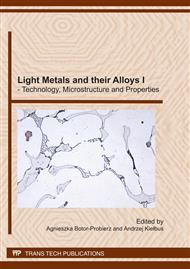p.11
p.21
p.29
p.35
p.39
p.49
p.55
p.63
p.75
Mechanical Properties of Aluminium Matrix Composites Reinforced with Glassy Carbon Particles
Abstract:
The mechanical properties of composite materials with glassy carbon (GC) have been presented. The effect of size and reinforcement value on tensile strength, impact and tribological characteristics (coefficient of friction and wear) were estimated. It has been found that the reinforcement value decide on mechanical properties. Enlargement of particles value leads to decreasing of tensile strength and impact strength. It has been shown that particle size has small influence on studied properties. Destruction energy for the composites with particles exceeding 100 µm is similar. The measurement of coefficient of friction proved, that increase of reinforcement value leads to decreasing of coefficient of friction from 0.4 for 5% value to about 0.12 for 20% of particle value. The coefficient of friction is comparable for the composites containing particles of 200 µm size and is less dependent on reinforcement value. However size of the particles decide on the character of coefficient of friction changes.
Info:
Periodical:
Pages:
39-48
Citation:
Online since:
June 2011
Authors:
Price:
Сopyright:
© 2011 Trans Tech Publications Ltd. All Rights Reserved
Share:
Citation:


